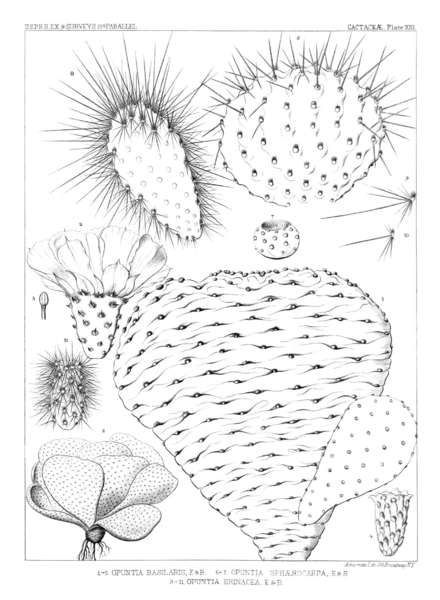User:Shazzy303/Opuntia basilaris
First assignment to edit a different article (California newt).[edit]
California newts reside in the coastal counties of California and in the southern Sierra Nevada and occupy a diverse array of habitats found near the small ponds and creeks where they breed, including woodlands and chaparral[1][2]
Information regarding main article I worked on.[edit]
Alright, it is decided that i'm going to update and edit the Opuntia basilaris article for my project. I'll be adding the following sections:
Lead Section - (Genus Species, growth form?)- did not end up updating.
Description - Describe leaves flowers fruiting bodies- description section seems pretty solid.
- Taxonomy - When was it discovered and described? Etymology, Major Synonyms, changes in classifications.
- Distribution and Habitat - Where does it grow? Geography, elevation, climate, soil type, desnity, clumping?
Ecology subsection - Interactions w the environment (pets pollinators disease) or conservation concerns
- Uses (Culture) - Hows it used by humans or cultivation details.
SECTION FOR PREPARING EDITS BEFORE PUBLISHING
Taxonomy[edit]

One of the first known descriptions of opuntia basilaris come from the reports of the explorations and surveys for a railroad route from the Mississippi River to the Pacific Ocean. This expedition followed the 35th parallel through New Mexico, Arizona, and California. In the 4th volume of this report, The Botany of the Expedition, by George Engelmann and John M. Bigelow, Opuntia basilaris is described as a stout fan shaped opuntia resembling an open cabbage head, with accompanying illustrations.[3]
Distribution and Habitat[edit]
This species of cactus is found in the Southwest US regions including California, Nevada, Arizona, Utah, and Northwestern Sonora, Mexico. This plant can be found in chaparral, desert, and grassland. This cactus grows in well draining mediums composed of sand, gravel, cobble, or even on boulders.[4][5]
Uses[edit]
The Diegueño would consume it as a dried fruit after removing the thorns.[6]
The Shoshone Native American Tribe took advantage of the analgesic properties of this cactus by creating a poultice from the inner mucilage to treat minor cuts. [7][8]
- ^ "California Newt (Taricha torosa) aCFNEx_CONUS_2001v1 Habitat Map - ScienceBase-Catalog". www.sciencebase.gov. Retrieved 2022-11-02.
- ^ Marchetti, Michael P.; Hayes, Abigail (2020-06-20). "Life History Variation in Two Populations of California Newt, Taricha torosa". Western North American Naturalist. 80 (2): 165. doi:10.3398/064.080.0204. ISSN 1527-0904.
- ^ Engelmann, George; Bigelow, John M. (1856). Pacific Railroad Survey Reports "The Botany of The Expedition". Vol. 4. Washington DC: US Government Printing Office. pp. 43–44.
- ^ Williams, Daniel; Cypher, Ellen; Kelly, Patrick; Miller, Karen; Norvell, Nancy; Phillips, Scott; Johnson, Cheryl; Colliver, Gary (1998). Recovery Plan for Upland Species of the San Joaquin Valley, California. Portland, Oregon: US Fish and Wildlife Service. pp. 49–50.
- ^ Anderson, Edward F. (2001). The Cactus Family. Portland, Oregon: Timber Press Inc. p. 498. ISBN 0-88192-498-9.
- ^ Ken., Hedges, (1986). Santa Ysabel ethnobotany. San Diego Museum of Man. ISBN 0-937808-42-3. OCLC 1170591869.
{{cite book}}: CS1 maint: extra punctuation (link) CS1 maint: multiple names: authors list (link) - ^ Moerman, Daniel E. (1998). Native American Ethnobotany. Timber Press, Incorporated. p. 365. ISBN 0-88192-453-9.
- ^ Shirazinia, Reza; Rahimi, Vafa Baradaran; Kehkhaie, Ashrafali Rezaie; Sahebkar, Amirhossein; Rakhshandeh, Hassan; Askari, Vahid Reza (2019-03-31). "Opuntia dillenii : A Forgotten Plant with Promising Pharmacological Properties". Journal of Pharmacopuncture. 22 (1): 16–27. doi:10.3831/KPI.2019.22.002. ISSN 2093-6966.
